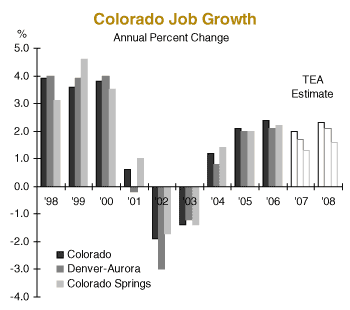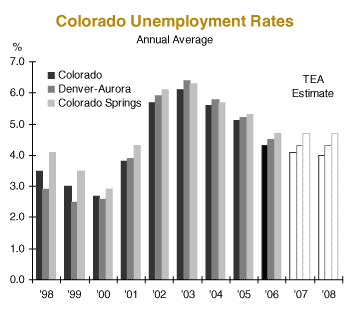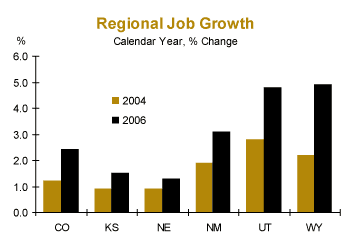|
Colorado Outlook
Spring 2007
6 and 5
Colorado employment growth during 2006 was the strongest of the past six years. The 52,800 net rise in total employment, a solid 2.4% growth rate, ranked among the dozen strongest job creation rates in the nation. Such job performance, while trailing the more powerful growth pace of the 1990s, is a welcome departure from the economic downturn of 2002 and 2003, when the state saw total employment plunge by 75,000 jobs. 
At the same time, the 4.3% average Colorado unemployment rate during 2006 was the lowest in five years. The state’s jobless rate has since moved even lower, with February’s 3.8% rate the lowest since July 2001. Tighter labor availability has occurred even as the flow of new residents to the state during 2004 to 2006 was the strongest since 2001.
Where the Jobs Are
Colorado employment growth has been led by strong gains in professional & business services, which accounted for one of every four jobs added during the most recent 12-month period. Solid employment gains have also occurred in leisure & hospitality; education & health services; government; trade, transportation & utilities; and natural resource sectors. The information, manufacturing, and construction sectors each noted modest employment declines over the most recent 12-month period. See chart on page 2 for regional performance.
More Colorado companies note their frustrations in filling open positions and pressures in retaining key employees. Such concerns are most prominent in the small business sector, where many firms cannot offer wage levels and benefit packages to match those of larger employers. However, those firms willing to pay higher wages, as well as firms that enjoy solid reputations as employers, are having many fewer labor availability problems.
 Colorado Homes Colorado Homes
Colorado’s residential real estate market has been quiet in recent years, even as the national market has been on a roller coaster ride. Colorado’s average home price appreciation of 3.32% during 2006 ranked #43 in the nation. By comparison, the average U.S. home value rose 5.87% during 2006, with dozens of housing markets around the nation seeing modest price declines.
The source of the data, the Office of Federal Housing Enterprise Oversight (OFHEO), is considered an accurate indicator of home prices. The data measures repeat sales and refinancings of millions of existing homes since 1975 in more than 375 communities.
While many homeowners and the media focus on the latest 12-month data, a five-year measure of price changes is also of value. The average American home value rose 55.21% between 2001 and 2006. By comparison, the average Colorado home rose 22.24%.
The modest 22.24% average home price appreciation over the past five years ranked Colorado in the bottom five states for that period. Recent Colorado home price appreciation has been relatively uneventful for homeowners when compared to various hot markets around the nation. However, more reasonable Colorado real estate values, especially as compared to those in Arizona, California, and Nevada, should allow Colorado residents to sleep better over the balance of 2007 and into 2008 as the nation’s real estate bubble continues to deflate (see pages 4-5 for additional nationwide housing detail).
The Rocky Mountain region led the nation’s real estate market during 2006, with an average rise of 8.98%. Utah led the states with an average rise of 17.55% in 2006 after ranking dead last in 2003. The average Denver-Aurora home value rose 1.32% in 2006, with a five-year gain of 16.75%. Boulder had one- and five-year gains of 1.68% and 15.17%, respectively. Colorado Springs recorded average home price gains of 4.70% in 2006 and 27.95% over the past five years. 
Fort Collins-Loveland saw average home values rise 0.85% and 17.10%, while Greeley registered 1.33% and 15.10% gains, respectively. Grand Junction saw stronger increases of 13.34% and 58.47%. Pueblo recorded gains of 5.35% and 21.83%, respectively.
Another major measure of home values—calculated by the National Association of Realtors—noted the median (half cost less, half cost more) existing American home value declined by 2.7% to $219,300 in 2006. Denver saw the median value dip by 0.8% to $245,600. The median Boulder home value rose 3.9% to $363,100, while the median Colorado Springs home value rose 4.9% to $219,400.
Colorado Outlook
The Colorado economy continues to grow at an attractive pace, a position likely to be maintained over the next 18 months. Such growth is a desirable alternative to the boom & bust history of the 1993-2003 period. Tighter labor markets will make life more challenging for Colorado employers of all shapes and sizes.
The Colorado real estate sector is healthy, with modest price appreciation expected over the next 12-18 months, even as hot national markets of the past few years see prices decline in 2007. On balance, the Colorado economic outlook remains solid.
|
